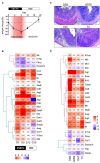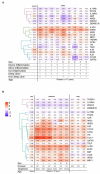Comparative Transcriptomics of IBD Patients Indicates Induction of Type 2 Immunity Irrespective of the Disease Ideotype
- PMID: 34136502
- PMCID: PMC8200538
- DOI: 10.3389/fmed.2021.664045
Comparative Transcriptomics of IBD Patients Indicates Induction of Type 2 Immunity Irrespective of the Disease Ideotype
Abstract
Inflammatory cytokines initiate and sustain the perpetuation of processes leading to chronic inflammatory conditions such as inflammatory bowel diseases (IBD). The nature of the trigger causing an inflammatory reaction decides whether type 1, type 17, or type 2 immune responses, typically characterized by the respective T- helper cell subsets, come into effect. In the intestine, Type 2 responses have been linked with mucosal healing and resolution upon an immune challenge involving parasitic infections. However, type 2 cytokines are frequently elevated in certain types of IBD in particular ulcerative colitis (UC) leading to the assumption that Th2 cells might critically support the pathogenesis of UC raising the question of whether such elevated type 2 responses in IBD are beneficial or detrimental. In line with this, previous studies showed that suppression of IL-13 and other type 2 related molecules in murine models could improve the outcomes of intestinal inflammation. However, therapeutic attempts of neutralizing IL-13 in ulcerative colitis patients have yielded no benefits. Thus, a better understanding of the role of type 2 cytokines in regulating intestinal inflammation is required. Here, we took a comparative transcriptomic approach to address how Th2 responses evolve in different mouse models of colitis and human IBD datasets. Our data show that type 2 immune-related transcripts are induced in the inflamed gut of IBD patients in both Crohn's disease and UC and across widely used mouse models of IBD. Collectively our data implicate that the presence of a type 2 signature rather defines a distinct state of intestinal inflammation than a disease-specific pathomechanism.
Keywords: IBD; chronic inflammation; intestine; type 2 immunity; ulcerative colitis.
Copyright © 2021 Gonzalez Acera, Patankar, Diemand, Siegmund, Neurath, Wirtz and Becker.
Conflict of interest statement
The authors declare that the research was conducted in the absence of any commercial or financial relationships that could be construed as a potential conflict of interest.
Figures



Similar articles
-
Development, validation and implementation of an in vitro model for the study of metabolic and immune function in normal and inflamed human colonic epithelium.Dan Med J. 2015 Jan;62(1):B4973. Dan Med J. 2015. PMID: 25557335 Review.
-
Innate and adaptive immunity in inflammatory bowel disease.Autoimmun Rev. 2014 Jan;13(1):3-10. doi: 10.1016/j.autrev.2013.06.004. Epub 2013 Jun 15. Autoimmun Rev. 2014. PMID: 23774107 Review.
-
Crohn's Disease and Ulcerative Colitis Show Unique Cytokine Profiles.Cureus. 2017 Apr 19;9(4):e1177. doi: 10.7759/cureus.1177. Cureus. 2017. PMID: 28533995 Free PMC article.
-
Current concepts of the etiology and pathogenesis of ulcerative colitis and Crohn's disease.Gastroenterol Clin North Am. 1995 Sep;24(3):475-507. Gastroenterol Clin North Am. 1995. PMID: 8809232 Review.
-
A galectin-specific signature in the gut delineates Crohn's disease and ulcerative colitis from other human inflammatory intestinal disorders.Biofactors. 2016 Jan-Feb;42(1):93-105. doi: 10.1002/biof.1252. Epub 2016 Feb 1. Biofactors. 2016. PMID: 26891020
Cited by
-
Eosinophilic esophagitis is associated with increased risk of later inflammatory bowel disease in a nationwide Swedish population cohort.United European Gastroenterol J. 2024 Feb;12(1):34-43. doi: 10.1002/ueg2.12493. Epub 2023 Dec 7. United European Gastroenterol J. 2024. PMID: 38058270 Free PMC article.
-
Dynamic, Transient, and Robust Increase in the Innervation of the Inflamed Mucosa in Inflammatory Bowel Diseases.Cells. 2021 Aug 30;10(9):2253. doi: 10.3390/cells10092253. Cells. 2021. PMID: 34571902 Free PMC article.
-
Multi-Omics Characterization of Colon Mucosa and Submucosa/Wall from Crohn's Disease Patients.Int J Mol Sci. 2024 May 8;25(10):5108. doi: 10.3390/ijms25105108. Int J Mol Sci. 2024. PMID: 38791146 Free PMC article.
References
LinkOut - more resources
Full Text Sources

